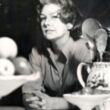The Oxford companion to food
(Book)
641.03 DAVID 2014 3rd ed.
1 available
Copies
| Location | Call Number | Status |
|---|---|---|
| Central - Adult Nonfiction | 641.03 DAVID 2014 3rd ed. | Available |
Description
More Details
Notes
Also in this Series
Published Reviews
Choice Review
This third edition comes 15 years after the first was published (CH, May'00, 37-4812). Both it and the second edition (2006) were compiled after Davidson's death. Due to the extent that each of these subsequent editions have strived to remain true to the original, there have been few substantive changes. An obvious cosmetic change is color. The second edition was done in a green theme (highlighting, etc.), the latest edition in orange. There also appear to be many more cross-references. Besides making the work that much more accessible to readers, this obviates the cross-reference index in the previous two editions. The original book was incredibly comprehensive (as evidenced by its 892 pages and the 20 years it took to produce). Writer/publisher Jaine added 72 new entries to the second edition and 43 more to the third. Further, Jaine states that he updated 250 of the original entries. In a book of this size, however, that indicates the vast majority remain the same. This makes it a valuable purchase for libraries or individuals that do not own the previous versions, but not an essential one for other audiences. Overall, the differences seem relatively slight. Summing Up: Highly recommended. Libraries that do not own earlier editions; all levels. --Susan Hurst, Miami University
Booklist Review
This update to the 2005 edition replicates the authoritative, comprehensive nature of the original editions while adding a wealth of new food-related information. More than 250 entries (out of 3,000) have been updated with new research, and 43 entries have been added, including Local food, Foraging, Leftovers, Obesity, and Henri Nestlé. There is a subject index at the beginning of the work and an extensive bibliography at the close. Over 200 line drawings are included. This dense, venerable resource remains highly recommended for food collections in libraries of all types and is a must-read for any foodie. Libraries with older editions should absolutely consider updating with this revision.--Vnuk, Rebecca Copyright 2015 Booklist
Library Journal Review
From particular things to eat to cuisine, techniques, and ingredients, this tome delivers everything food. Most ingredient entries are organized by common rather than scientific names. The bibliography is quite extensive, and well researched. The space is given to text and research, with only a few diagrams and drawings of possibly lesser-known ingredients, such as kohlrabi (cabbage). Entries covering items that include the biscuit and biscuit varieties demonstrate not only the depth but also the British bias of the text. While it is noted that there is a difference in biscuit styles between the United States and Great Britain, the emphasis of the articles is on the British biscuit. This is evidenced again with coverage of corn (a cereal grain) and maize as with other variants in the languages throughout the material. VERDICT Illustrating a level of reference detail not common in food and food-related works, this title will appeal to the foodie, home cook, food lover, chef, food researcher, and hungry person. While overall it is comprehensive and thorough, the British bias may detract from the appeal to an American audience.-Dawn Lowe-Wincentsen, Oregon Inst. of Technology, Portland (c) Copyright 2014. Library Journals LLC, a wholly owned subsidiary of Media Source, Inc. No redistribution permitted.
Booklist Reviews
This update to the 2005 edition replicates the authoritative, comprehensive nature of the original editions while adding a wealth of new food-related information. More than 250 entries (out of 3,000) have been updated with new research, and 43 entries have been added, including Local food, Foraging, Leftovers, Obesity, and Henri Nestlé. There is a subject index at the beginning of the work and an extensive bibliography at the close. Over 200 line drawings are included. This dense, venerable resource remains highly recommended for food collections in libraries of all types—and is a must-read for any foodie. Libraries with older editions should absolutely consider updating with this revision. Copyright 2014 Booklist Reviews.
Library Journal Reviews
From particular things to eat to cuisine, techniques, and ingredients, this tome delivers everything food. Most ingredient entries are organized by common rather than scientific names. The bibliography is quite extensive, and well researched. The space is given to text and research, with only a few diagrams and drawings of possibly lesser-known ingredients, such as kohlrabi (cabbage). Entries covering items that include the biscuit and biscuit varieties demonstrate not only the depth but also the British bias of the text. While it is noted that there is a difference in biscuit styles between the United States and Great Britain, the emphasis of the articles is on the British biscuit. This is evidenced again with coverage of corn (a cereal grain) and maize as with other variants in the languages throughout the material. VERDICT Illustrating a level of reference detail not common in food and food-related works, this title will appeal to the foodie, home cook, food lover, chef, food researcher, and hungry person. While overall it is comprehensive and thorough, the British bias may detract from the appeal to an American audience.—Dawn Lowe-Wincentsen, Oregon Inst. of Technology, Portland
[Page 131]. (c) Copyright 2014. Library Journals LLC, a wholly owned subsidiary of Media Source, Inc. No redistribution permitted.Reviews from GoodReads
Citations
Davidson, A., Jaine, T., & Vannithone, S. (2014). The Oxford companion to food (Third edition /). Oxford University Press.
Chicago / Turabian - Author Date Citation, 17th Edition (style guide)Davidson, Alan, 1924-2003, Tom, Jaine and Soun, Vannithone. 2014. The Oxford Companion to Food. Oxford, United Kingdom: Oxford University Press.
Chicago / Turabian - Humanities (Notes and Bibliography) Citation, 17th Edition (style guide)Davidson, Alan, 1924-2003, Tom, Jaine and Soun, Vannithone. The Oxford Companion to Food Oxford, United Kingdom: Oxford University Press, 2014.
Harvard Citation (style guide)Davidson, A., Jaine, T. and Vannithone, S. (2014). The oxford companion to food. Third edn / Oxford, United Kingdom: Oxford University Press.
MLA Citation, 9th Edition (style guide)Davidson, Alan, Tom Jaine, and Soun Vannithone. The Oxford Companion to Food Third edition /, Oxford University Press, 2014.




























